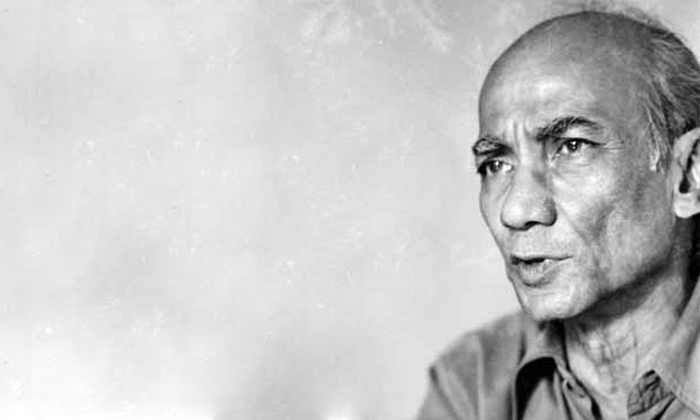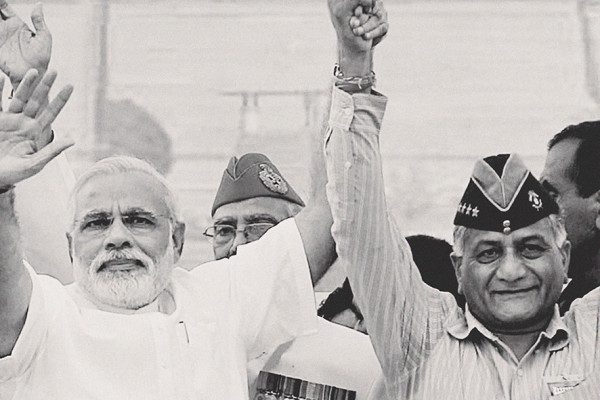Two young activists Sabuj Mukherjee and Bandikishore Mitra have come out with a remarkable edition of a book dedicated to a long interview (in Bengali) with Badal Sircar titled: The cheapest meat to consume would be human flesh.
Amidst the Badalda books that have flooded the market in recent years, this is easily one of the best publications. The interview is freewheeling and focuses on the different streams that flowed into Badalda’s thought process.
This long interview is a testimony to his continuous engagement and his personal and ideological struggles to remain independent.
Flashback: How does Bhoma look? Is he a representation of the impoverished, or a mirror image of all that is dysfunctional in our different relationships-ranging from personal to political? Or is Bhoma an instinctive call to rebel? Bhoma (the almost mute Sunderban tribal who chops off wood endlessly and one day takes on the tiger) keeps on haunting me, scooping out large chunks of my consciousness.
How does Bhoma look?
Flash-Forward: I belong to a crossroad-generation that neither embraced the sixties nor could handle the onset of technological mechanicality like a duck taking to water (do they?). I belong to a generation, where some of our theatre likes its bare essentials to be unsponsored. Unfailingly so.
Flashforward: What has Badal Sircar’s theatre given me? Definitely not hours of pleasure because most of the time it filled me with a recurring dilemma, the pain of experiencing the Leftist melancholia, the pain that makes a Kanu Sanyal commit suicide and a Jangal Santhal hit the bottle.
I think the time has come to look at our response towards his later texts and re-discover certain nuances that we understood yet chose to ignore, not limit ourselves to the visual narrative of movement patterns and myriad structures created by the body.
What I learnt most are shape-shifting techniques, and reacting to all kinds of architecture as a theatre space.
Coming back to the here and now: Badal Sircar’s theatre gave me the power to transcreate texts. The realisation that the seed of a script is hidden in anything that we perceive. From a stray piece of paper lying on the highway, to punchlines of advertisements on billboards to your grandmother’s forgotten recipe to the constant evolution of proverbs (today’s commercial one-liner is tomorrow’s proverb) and even stray, unimportant daily soundscape.
Which is why I feel Janmabhumi Aaj (Our Motherland today), Bhoma, Michhil, Spartacus, Khatmat Kringg and Manushe Manushe (People to People) are a much greater milestone in national theatre than Pagla Ghoda, Baki Itihash, Spartacus and Bagh.
Today’s generation needs to know about Badal Sircar and his works. And this slim book of interviews is a great primer to have at your side when you dip into his works.
Throughout the interview, Badalda insists that theatre stripped to its bare essentials will reveal the true essence and power of the medium, because we cannot hope to outspend a Hollywood or Bollywood product by mounting the costliest of musicals on proscenium. The feel of intimate theatre can never be replicated in a cinema complex or through an idiot box or even through a city-centric proscenium approach.
But it is easier said than done. Our propensity to envelope theatre with all its trappings is a commercial urge and a trend.
I guess the interview reveals that the Badal Sircar method is all about self-discovery. His work either influences your theatre or it does not. You cannot remain neutral and play the coy/oversmart critic in saying that could have been this and this could have been that.
The salient characteristics that emerge from the philosophy of this ‘other’ theatre are:
1. It is portable, flexible and free. Portable also means that it can be performed anywhere without any compromise. The village folk would not see an ideologically and technologically dumbed down version compared to a city-bred audience. The performance should be designed in such a way that it be same both for the rural and urban audiences. Flexible would also mean the performance could have the elasticity of both expanding and squeezing itself and fitting into every time frame, every space and under any condition. Free would also mean un-sponsored and non-ticketed, purely surviving on personal donations and resource-sharing.
2. No bulky sets, no grand lighting scheme, no heavy properties.
3. Body becomes a central mode of communication and sometimes the only one, concurrent with both the text and the concept.
4. Spectator and the performer are at the same eye level. Both physically and metaphorically.
5. Words, sound, movement, non-verbal improvisation must all combine to open up a critical debate on prevailing dogmas. But it should be done as directly as possible.
We need to draw up a comprehensive list of Badalda’s works. Badalda as an original playwright, Badalda as a dramaturg and transcreator (who adapted works of Girish Chandra Ghosh, Rabindranath Tagore, Bertolt Brecht, George Bernard Shaw, Vaclav Havel, Graham Greene, Shakespeare, Gaurkishore Ghosh, Tarashankar Banerjee, Peter Shaffer, Birendra Chattopadhyay, Monibhushan Bhattacharya, Navendu Sen, Mohit Chattopadhyay, oral rendering of an anecdote told to him by Rangabelia-based activist Tushar Kanjilal, Mahasveta Devi among others. Badalda the activist-his incisive essays on the hazard of nuclear weapons… Badalda the little magazine writer (his interesting take on Greek mythology was published in a the magazine Karukatha as a cycle of work-in-progress)…Badalda-the solo performer with his searing rendition of Tara Shankar Banerjee’s Nagini Kanyar Kahini where folklore segues into myth which in turn merges into a lived present and again that present knocks at the door of the past, Badalda-the essayist… look at this lovely introduction to Barin Saha’s screenplay of Tero Nodir Pare… Badalda-the collage artist, Badalda-travelogue writer, Badalda-the workshop designer who went beyond the conventional academic pedagogy of learn-recall-remember and standardised theatre exercises into a realm of lived-unrehearsed pain.
It is the re-visiting aspect which the book needs to incorporate in its next edition. A detailed list of plays should have been added so that the references and their contexts could have been more accessible to the reader.
His kind of dissent constantly strove to be independent, without being co-opted by government or corporate patronage.
When one finishes the book and looks for the central kernel of Badalda’s discourse, personally I feel it is his lifelong jihad against the idea of ownership of a performance. Performance, necessarily as means of co-creation, constant evolution of the text to reveal the skeleton lurking behind the body of words and not the royalty-driven, license-driven, rights-driven approach. Something closer to what Gandhi did with his first edition of Hind Swaraj in English. Bapu merely states “No Rights Reserved.”
One may agree or disagree with the stance but then that is the point. You can either be a Vishwabharati who felt that owning Tagore was their holy duty or you can be more egalitarian like Navjivan Trust. The trust was clear about the fact that when copyright laws on Gandhiji’s works expired (which it did in 2009), no extension would be sought (even if a statutory short term extension could be legally granted).
He chose his calling and his was an informed choice.
This book is about that informed choice. The dialectics of that choice, the commitment behind the choice and a life dedicated to make that choice sharper, more people-centric and more participatory.
Yes, Badal Sircar, remains a frontier, a parameter, a yardstick of theatrical integrity. And that is why we need to constantly go back and understand the core of what ‘third theatre’ stands for, in these days of sponsored riots, rampant communalism and sponsored ideologies.














